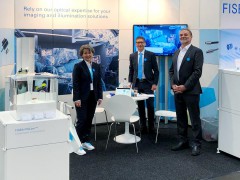
Zhenyu Hou: How long can Moore’s law continue?
source:Laser Manufacture News
keywords:
Time:2016-09-28
Zhenyu Hou is an engineer in AMSL in United States. It's a good opportunity that Laser Manufacture News to have this interview with Dr. Hou.
LMN: Dr. Hou, thank for accepting this interview with Laserfair.com. Can you tell our readers what is Moore’s law? Why it’s important?
A1: OK, no problem. Moore’s law is named after the co-founder of Intel, Gordon Moore, in 1965. Moore’s Law predicted a trend where the number of transistors per chip doubles every year initially. Later, in 1975 it was revised to be roughly two years. The outcome of Moor’s law is that the computation power per cost of the chip continues to increase, which makes computation cheaper and cheaper. Moore’s prediction has been proved to accurate for many decades and has contributed to world economic growth in the late twentieth and early twenty-first centuries.
LMN: Then why many media now are starting to question if Moore’s law will still apply?
A2: To answer this question, we need to look at the history of Moore’s law. Although the Moore’s law seemed to be very successful, it was not exactly easy. As the transistors becoming smaller and smaller, many issues such as heat management, leakage, are affecting the performance of transistors. A lot of money and R&D were invested in academia and industry to resolve these difficulties in chip making over the decades. Intel’s FinFET is one of the successful examples of technical innovations helped to sustain the Moore’s law. If it were not for these extraordinary efforts, Moore’s law wouldn’t have been sustaining. However, as many researchers believed that we are approaching the theoretic limits of chip making – that is when transistor size is approaching sub 5nm, quantum effect such as uncertain principles will be significant enough to change the whole working principle of transistor.For the exact reason, many reporters, and even many researchersforesee that Moore’s law will ends in a matter of few years.
LMN:Dr. Hou, what’s your opinion on this issue?
A3: Frankly speaking, my opinion is that Moore’s law will still sustain for a long period of time given enough investment in the field. As an old Chinese saying goes, “Monay makes the mare go.” The reason is that, fundamentally, it is an economic problem. Ifthe world would spend enough investment, one way or another, we will overcome these difficulties – because human are so smart. One important thing to remember is that: we cannot just look at this problem is a one-dimensionally- there are many other dimensions we could look into to solve the end problem. For example, FinFET technology changes the traditional 2D architecture to 3D architecture, which successfully resolved the heat dissipation and other problem with high-density transistors.
LMN:If what you said were correct, what are the most promising technologies that would make Moore’s law to continue?
A4: We all know that the clock speed in CPUs is really hard to improve these days. We need to look for alternative ways to make CPUs faster. Currently the processing cores in a CPU are mostly connected with metal wires, which is a main restricting factor that limited the communication speed of CPU. If the number of cores becomes larger, the efficiency of the interconnections will degrades exponentially and become the bottleneck of overall CPU speed. Using optical interconnects is the solution to this problem. In fact, scientists have already noticed this and start to make better computers by taking advantages of the optical interconnect. One example is the fastest supercomputer Sunway TaihuLight in 2016 which is from China. It actually uses optical switches between processor cores for data communications. The result is much faster yet more energy efficient supercomputers. So I believe using optical interconnect in CPU architecture is the trend of future.
LMN:Dr. Hou, Thank you very much for sharing your expertise. Can you summarize and tell us how do you see the future of Moore’s law?
A5: My opinion is that technology is driven by economy. As long as there is market, technology will make it happened. Nowadays, mobile computing, Big Data, Artificial Intelligence have changed and will continue to change people’s life. The demand for more powerful computation and data processing chips are higher than ever. In order to keep up with the overwhelming demanding, the industry is working hard to catch up with innovative technologies such as optical interconnects. The prediction of ending of Moore’s law had been proven to be failed time and time again in the past decades. I am confident it is not the case again in the near future. The strong demand for processing power will motivate us to make technology innovation to overcome the issues. On the other hand, the advancement of technology will in turn push the use of big data, artificial intelligence to another higher level.
- RoboSense is to Produce the First Chinese Multi-beam LiDAR
- China is to Accelerate the Development of Laser Hardening Application
- Han’s Laser Buys Canadian Fiber Specialist CorActive
- SPI Lasers continues it expansion in China, appointing a dedicated Sales Director
- Laser Coating Removal Robot for Aircraft
 FISBA exhibits Customized Solutions for Minimally Invasive Medical Endoscopic Devices at COMPAMED in
FISBA exhibits Customized Solutions for Minimally Invasive Medical Endoscopic Devices at COMPAMED in New Active Alignment System for the Coupling of Photonic Structures to Fiber Arrays
New Active Alignment System for the Coupling of Photonic Structures to Fiber Arrays A new industrial compression module by Amplitude
A new industrial compression module by Amplitude Menhir Photonics Introduces the MENHIR-1550 The Industry's First Turnkey Femtosecond Laser of
Menhir Photonics Introduces the MENHIR-1550 The Industry's First Turnkey Femtosecond Laser of Shenzhen DNE Laser introduced new generation D-FAST cutting machine (12000 W)
more>>
Shenzhen DNE Laser introduced new generation D-FAST cutting machine (12000 W)
more>>





